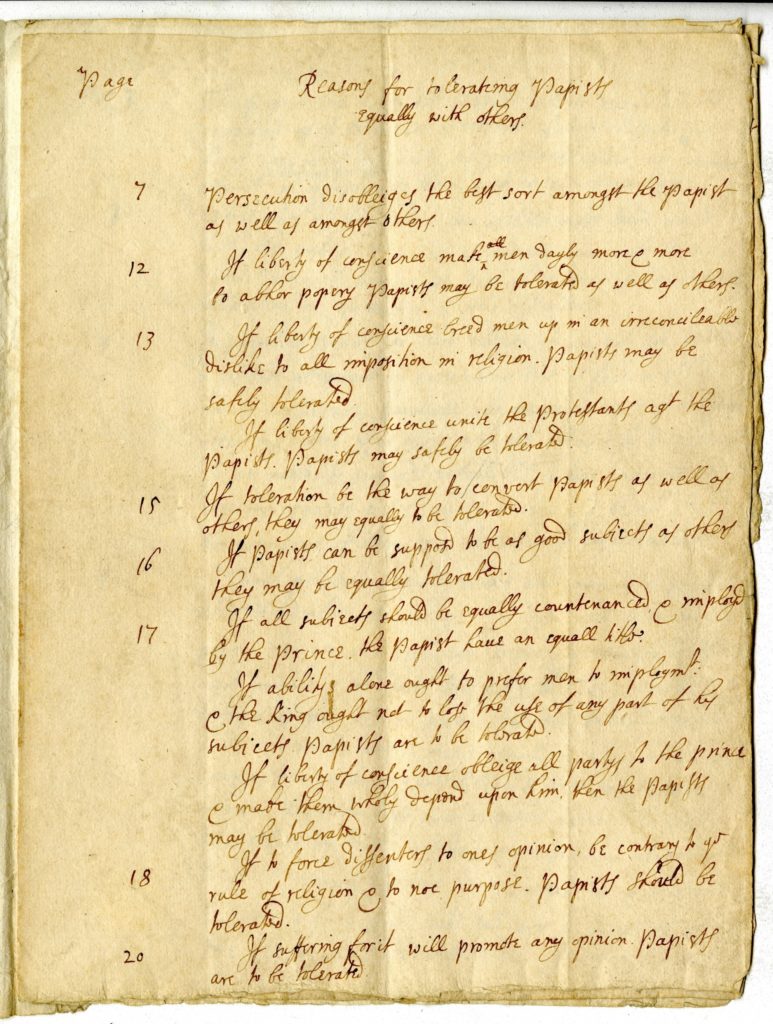Locke’s Toleration in America
Craig Walmsley
Cover image: Portrait of John Locke by Godfrey Kneller, 1697. Wikimedia Commons.
A new Locke manuscript comes to light in the United States.
Philosophers have consequences – and few have been more consequential than John Locke (1632-1704). His Essay concerning Human Understanding (1689) was the first modern statement of empiricism, ranking alongside Newton’s Principia in significance for many of their eighteenth-century successors. His Two Treatises on Government (1689) made a monumental contribution to the development of modern political theory. In his Letter Concerning Toleration (1689), Locke argued that ‘Church’ and ‘State’ were separate entities, with separate purposes, one having no jurisdiction over the other’s concerns. Thomas Jefferson thought Locke one of the ‘greatest men that ever lived’ and drew directly on Locke’s work in the Two Treatises when writing the Declaration of Independence. James Madison was inspired by Locke’s work on the separation of church and state, and translated it into the First Amendment’s guarantee that ‘Congress shall make no law respecting an establishment of religion, or prohibiting the free exercise thereof’. It is perhaps apt, then, that a new John Locke manuscript has recently been discovered in the United States that sheds new light on the origin and evolution of Locke’s views on toleration.
Locke’s first arguments on this subject were put forward in his 1667-8 Essay Concerning Toleration. At the time Locke was writing, religious uniformity was considered essential to social stability, and was rigorously enforced by law. But political reversals in 1667 meant Charles II had to seek support amongst “nonconformists”. One key question was whether this toleration should extend to any denomination of Protestant, or as far as Catholics. Even at his most tolerant, Locke is usually supposed to have excluded Catholics since they were thought to give their allegiance to a foreign power: the Pope.
It is remarkable, then, that the Greenfield Library of St John’s College, Annapolis, preserves a manuscript in Locke’s hand, entitled ‘Reasons for tolerateing Papists equally with others’ (hereafter ‘Reasons’), and dated to 1667. (The analysis presented below owes a very great debt to the co-author of our paper on this discovery, Felix Waldmann, J. H. Plumb College Lecturer and Fellow, Christ’s College Cambridge.) The manuscript comprises two sets of notes. The first, shorter set presents arguments for the toleration of ‘Papists’; the second set, more than twice as long as the first, presents arguments against. Each note has a number in the margin, suggesting that these were Locke’s response to another, unidentified work. Comparing these passages with publications on toleration from 1667–8, Jacqueline Rose at the University of St. Andrews identified Charles Wolseley’s Liberty of conscience, the magistrates interest (1667) as Locke’s source. Wolseley supported toleration on the grounds of the ‘interest’ of the state – it was in the King’s political interest, it was in the interest of the Protestant faith, and it was in commercial interest of the kingdom to tolerate non-conformists. But Wolseley was typical of his time in assuming that Catholics’ allegiance to a foreign power made them suspect. They were not to be tolerated.

Source: Greenfield Library, St. John’s College, Annapolis, BR1610.L8 232, fo. 1r. Cambridge Core.
So it is somewhat surprising that in the first set of notes in the ‘Reasons’, Locke recast and repurposed Wolseley’s arguments as a means to defend the toleration of Catholics. He writes that ‘[i]f abilitys alone ought to prefer men to imployment & the King ought not to lose the use of any part of his subjects, Papists are to be tolerated’, and ‘[i]f Papists can be supposd to be as good subjects as others, they may be equally tolerated’. These sentiments appear nowhere in Locke’s published writings and are remarkable to see from his pen. The second set of notes advances more familiar counterarguments at some length: Catholics were intolerable, because of their ‘dangerous & factious tenents in reference to the state’. Here we seem to see Locke in the process of working through the arguments on either side, making up his mind exactly how far toleration should extend.
Equally striking is the intimate relationship between the ‘Reasons’ and Locke’s 1667-8 Essay Concerning Toleration – the prototype for the arguments presented in his 1689 Letter Concerning Toleration. The first draft and the Essay proper were sold at Sotheby’s in 1922 from the collection of E. C. A Sanford, the descendent of Locke’s friend Edward Clarke. The ‘Reasons’ was sold alongside them. An inspection of the physical composition of the ‘Reasons’, the first draft, and parts of the Sotheby’s manuscript of the Essay reveals that were all written on the same type of paper, suggesting they were composed at the same time. Close reading of the corrections and deletions of the first draft of the Essay reveals its initial focus on Catholics.
Locke commenced the first draft by saying that there were ‘two sorts of things that have a right to toleration’: ‘speculative opinions’ and ‘the place time & manner of worshiping my god’. He then continued, ‘to both these papists & all mankinde seeme to have a title’, underlining this phrase. This suggests that Locke began the first draft of the Essay with the toleration of Catholics in mind. The paper continues in broad vein as Locke marshals his arguments for toleration, setting the tone for much of his later writing on the subject: ‘I ought to have liberty in my religious worship, because it is a thing betweene god and me, & is of an eternall concernment wheras the magistrate is umpire between man & man’.
Four out of the five policy proposals at the end of the first draft also relate to Catholics. Locke held that while ‘Papists & all other men have a right to toleration of their religious worship & speculative opinions’, ‘Papists haveing adopted into their religion as fundamentall truths, severall opinions, that are oposite & destructive to any government but the popes, [they] have noe title to toleration’. The fifth and last proposal was a later addition covering ‘all other dissenters’, broadening the draft’s scope beyond Locke’s focus on Catholics. The opening and conclusion of the first draft thus focused on the toleration of Catholics, as if that was the point of the paper overall. Indeed, the conclusions drawn were emphatic, and Locke was never to substantially revise them.
The first page of Locke’s previously undiscovered manuscript “Reasons for tolerateing Papists equally with others.” Source: Greenfield Library, St. John’s College, Annapolis, BR1610.L8 232, fo. 1r. Cambridge Core.
In the first draft of the Essay, Locke appears to be building out his initial arguments concerning Catholics from the ‘Reasons’ into a theory of toleration which could be applied more generally. Apparently thinking that a more comprehensive and systematic treatment of toleration was required, Locke then commenced the Essay proper. A detailed comparison of the ‘Reasons’ with the Essay shows that Locke recycled passages from the former in the latter.
It appears, then, that the questions examined in the ‘Reasons’ were the immediate inspiration and stimulus for Locke’s Essay concerning toleration. The early drafts of the Essay are successively more elaborate treatments of issues raised in the ‘Reasons’, and parts of the ‘Reasons’ re-appear in later drafts of the Essay. The precedence of the ‘Reasons’ also provides an explanation for the writing of the Essay: Locke was considering the toleration of Catholics, possibly in anticipation of Charles II packaging a form of toleration for nonconformists with a concession to ‘papists’.
Locke has always been viewed as implacably opposed to the toleration of Catholics. The ‘Reasons’ shows that he gave the matter detailed consideration, marshalling arguments for it with startling impartiality, before coming down against it. It appears that the ‘Reasons’ preceded and probably inspired Locke’s more systematic Essay concerning toleration. And it was in this Essay that Locke first formulated many of the principles that we now associate with him as an architect of the religious freedoms we take for granted in modern democracies.
Philosophers do have consequences, though not always those they suppose. Locke argued for religious tolerance, but only within strict limits. Despite these limits, Locke’s arguments would ultimately be extended by his successors to all religious faiths as part of a more pluralistic conception of society. The discovery of this manuscript, and Locke’s concerns about the “dual loyalty” of Catholics, are an opportune reminder that some still seek to abrogate the freedom of religion, for reasons even less convincing than those Locke articulated. It provides useful occasion to recall the foundational importance of religious tolerance in western society in general, and the United States in particular.
A transcription and discussion of ‘Reasons for tolerateing Papists equally with others’ is presented in “John Locke And The Toleration Of Catholics: A New Manuscript”, J. C. Walmsley and Felix Waldmann, in The Historical Journal.

J. C. Walmsley is Senior Director of Design Strategy at Publicis Sapient and Editor at the Clarendon Edition of the Works of John Locke.
Recommended Citation
Walmsley, Craig. “Locke’s Toleration in America.” Canopy Forum, October 15, 2019. https://canopyforum.org/2019/10/15/lockes-toleration-in-america-by-craig-walmsley/


